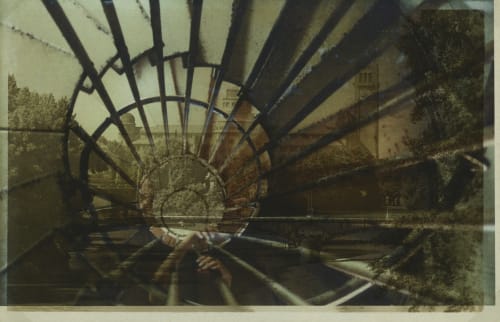This exhibition features over 30 color-pigment self-portraits that Anrakuji meticulously printed on vintage postcards (in Japanese, ehagaki – picture postcard) collected by her grandfather at the turn of the last century.
Emi Anrakuji is known for taking obscured and often close-up images of herself (all but her eyes) in mundane surroundings with evocative atmospheres. This exhibition features over 30 color-pigment self-portraits that Anrakuji meticulously printed on vintage postcards (in Japanese, ehagaki – picture postcard) collected by her grandfather at the turn of the last century. The grandfather, a wine importer in Tokyo, frequently traveled to Europe and brought back these postcards, a popular novelty among collectors especially from the1890s to the1910s. According to Anrakuji’s family lore, a box of the well-preserved old postcards miraculously survived the 1923 earthquake and the WWII air raids in 1945. On both occasions, the fire burned down the city of Tokyo almost entirely, including her grandfather’s shop. Therefore, these postcards became a family treasure passed down through the generations.
In the early 2000s, Anrakuji was struck by these images/objects that cross lines of geography, economy, and politics revealing a complex history of visual culture. In them, she felt a strong connection to her grandfather who passed away well before she was born. For the most part, Anrakuji kept these works private, except for permitting some of them to be published as a book as well as creating color prints from the originals. For the first time, this exhibition presents the original works with unreplaceable value. Each work demonstrates a lyrical and sometimes provocative interplay between Anrakuji’s own shadowy figure and the miniature landscapes, buildings, ruins, and artifacts portrayed a century before by commercial photographers. The wide-ranging origins of images from Italy, the Netherlands, France, Great Britain, Belgium, the United States, Japan, China, and Egypt evoke nostalgia for the steamship journeys of the golden age. With these pieces, Anrakuji transcends time and space, triumphantly turning her family saga into an immortal palimpsest.


